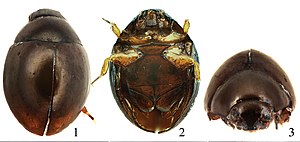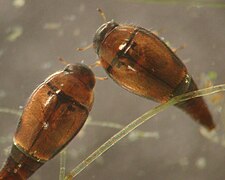Myxophaga
| Myxophaga Temporal range:
| |
|---|---|

| |
| Satoniuskurosawai(Torridincolidae) | |
| Scientific classification | |
| Domain: | Eukaryota |
| Kingdom: | Animalia |
| Phylum: | Arthropoda |
| Class: | Insecta |
| Order: | Coleoptera |
| Suborder: | Myxophaga Crowson,1955 |
| Families | |
|
Hydroscaphidae | |
Myxophagais the second-smallest suborder of theColeopteraafterArchostemata,consisting of roughly 65 species of small to minutebeetlesin four families. The members of this suborder areaquaticandsemiaquatic,and feed onalgae.
Description
[edit]Myxophaga have several diagnostic features: the antennae are more or less distinctly clubbed with usually fewer than nine segments, mesocoxal cavities are open laterally and bordered by a mesepimeron and metanepisternum, the hind wings are rolled apically in the resting positions. Internally, they are characterised by the presence of sixmalpighian tubulesand the testes are tube-like and coiled.[1]
Beetles of this suborder are adapted to feed on algae. Their mouthparts are characteristic in lackinggaleaeand having a mobile tooth on their left mandible.[2]
Taxonomy
[edit]There are four extant families in the suborder Myxophaga divided between two superfamilies,[3]containing about 65 described species,[4]and at least one extinct family.[a]
SuperfamilyLepiceroideaHinton,1936
- FamilyLepiceridaeHinton,1936
- LepicerusMotschulsky,1855
- †LepiceratusJałoszyński et al. 2020[5]
SuperfamilySphaeriusoideaErichson,1845
- FamilyHydroscaphidaeLeConte,1874
- HydroscaphaLeConte, 1874
- ScaphydraReichardt, 1973
- YaraReichardt & Hinton, 1976
- ConfossaShort, Joly, García & Maddison, 2015
- FamilySphaeriusidaeErichson,1845
- SphaeriusWaltl,1838
- BezesporumFikáček et al. 2022[6]
- †BurmasporumKirejtshuk 2009[7]
- †CrowsonaeriusLi & Cai in Li et al. 2023[8]
- FamilyTorridincolidaeSteffan,1964
- ClaudiellaReichardt & Vanin, 1976
- DeleveaReichardt, 1976
- IapirPy-Daniel, da Fonseca & Barbosa, 1993
- IncoltorridaSteffan, 1973
- SatoniusEndrödy-Younga,1997
- TorridincolaSteffan, 1964
- YtuReichardt, 1973
Family †TriamyxidaeQvarnström et al. 2021
Unplaced in family
- †LeehermaniaChatzimanolis et al. 2012[5]
Distribution
[edit]Living members of Lepiceridae are confined to northern South America and Central America. Members of Sphaeriusidae occur on all continents except Antarctica, while Hydroscaphidae occurs on all continents except Australia and Antarctica. Torridincolidae occurs in Africa, Asia, and South America.[10]
Fossil record
[edit]The fossil record of myxophagan beetles is sparse, likely due to their small size limitingpreservation potential.[5]The currently oldest myxophagan isTriamyxa,described in 2021 from numerous specimens of found in acoprolitefound in Late Triassic (Carnian) aged sediments in Poland. It was placed in its own monotypic family Triamyxidae, and was resolved as either the most basal myxophagan or sister to Hydroscaphidae.[9]The next oldest isLeehermaniafrom the Late Triassic (Norian)Cow Branch Formationof North Carolina, which had previously been interpreted as the oldest knownrove beetlebut in 2019 was reinterpreted as an early diverging relative of the family Hydroscaphidae.[5]A fossil impression assigned to the living genusHydroscaphain Hydroscaphidae is known from theYixian Formationin theJehol Biota,dating from theEarly Cretaceous(Aptian).[11]Fossils from the early Late Cretaceous (Cenomanian) agedBurmese amberfrom Myanmar, have been assigned to the extant genusLepicerusand extinct genusLepiceratuswithin Lepiceridae,[12][13][14]as well as the extantSphaeriusandBezesporumand the extinctBurmasporumandCrowsonaerius,belonging to Sphaerusidae.[7][8][6]
Gallery
[edit]-
Specimen ofSphaeriusminutus(Sphaeriusidae) in various views
-
Specimens ofHydroscaphanatans(Hydroscaphidae)
-
Specimen ofLepicerusinaequalis(Lepiceridae)
See also
[edit]Notes
[edit]- ^† Denotes that the group is extinct
References
[edit]- ^Beutel, R.; Leschen, R. (2005). "Morphology and Systematics (Archostemata, Adephaga, Myxophaga, Polyphaga partim)".Band 4 Part 38: Arthropoda, Hälfte: Insecta, Coleoptera, Beetles.Handbuch der Zoologie/Handbook of Zoology.Vol. 1.Walter de Gruyter.ISBN3-11-017130-9.
- ^Beutel & Leschen 2005,p. 43
- ^"Myxophaga".Tree of Life Web Project. 2007.Retrieved2017-05-26.
- ^Mesaros, Gabor (2013)."Sphaeriusidae (Coleoptera, Myxophaga): A new beetle family to the fauna of Serbia".Bulletin of the Natural History Museum(6): 71–74.doi:10.5937/bnhmb1306071m.
- ^abcdFikáček, Martin; Beutel, Rolf G.; Cai, Chenyang; Lawrence, John F.; Newton, Alfred F.; Solodovnikov, Alexey; Ślipiński, Adam; Thayer, Margaret K.; Yamamoto, Shûhei (January 2020)."Reliable placement of beetle fossils via phylogenetic analyses – Triassic Leehermania as a case study (Staphylinidae or Myxophaga?)".Systematic Entomology.45(1): 175–187.Bibcode:2020SysEn..45..175F.doi:10.1111/syen.12386.ISSN0307-6970.S2CID203407211.
- ^abFikáček, Martin; Yamamoto, Shûhei; Matsumoto, Keita; Beutel, Rolf G.; Maddison, David R. (2022-12-07)."Phylogeny and systematics of Sphaeriusidae (Coleoptera: Myxophaga): minute living fossils with underestimated past and present-day diversity".Systematic Entomology.48(2): 233–249.doi:10.1111/syen.12571.ISSN0307-6970.S2CID254440169.
- ^abKirejtshuk, A. G. (2009)."A new genus and species of Sphaeriusidae (Coleoptera, Myxophaga) from Lower Cretaceous Burmese amber"(PDF).Denisia.26:99–102.
- ^abLi, Yan-Da; Ślipiński, Adam; Huang, Di-Ying; Cai, Chen-Yang (2023-01-11)."New fossils of Sphaeriusidae from mid-Cretaceous Burmese amber revealed by confocal microscopy (Coleoptera: Myxophaga)".Frontiers in Earth Science.10:901573.Bibcode:2023FrEaS..10.1573L.doi:10.3389/feart.2022.901573.ISSN2296-6463.
- ^abQvarnström, Martin; Fikáček, Martin; Vikberg Wernström, Joel; Huld, Sigrid; Beutel, Rolf G.; Arriaga-Varela, Emmanuel; Ahlberg, Per E.; Niedźwiedzki, Grzegorz (June 2021)."Exceptionally preserved beetles in a Triassic coprolite of putative dinosauriform origin".Current Biology.31(15): 3374–3381.e5.Bibcode:2021CBio...31E3374Q.doi:10.1016/j.cub.2021.05.015.PMID34197727.
- ^Sampaio, Brunno H.L.; Short, Andrew E.Z. (2018),"Families Hydroscaphidae and Torridincolidae",Thorp and Covich's Freshwater Invertebrates,Elsevier, pp. 519–525,doi:10.1016/b978-0-12-804223-6.00022-6,ISBN978-0-12-804223-6,retrieved2021-07-26
- ^Cai, C.; Short, A. E. Z.; Huang, D. (2012). "The First Skiff Beetle (Coleoptera: Myxophaga: Hydroscaphidae) from Early Cretaceous Jehol Biota".Journal of Paleontology.86(1): 116–9.Bibcode:2012JPal...86..116C.doi:10.1666/11-050.1.S2CID140170420.
- ^Kirejtshuk, A. G.; Poinar, G. (2006). "Haplochelidae, a new family of cretaceous beetles (Coleoptera: Myxophaga) from Burmese amber".Proceedings of the Entomological Society of Washington.108:155–164.
- ^Ge, S. Q.; Friedrich, F.; Beutel, R. G. (2010)."On the systematic position and taxonomic rank of the extinct myxophagan dagger Haplochelus (Coleoptera)".Insect Systematics and Evolution.41(4): 329–338.doi:10.1163/187631210X537385.
- ^Jałoszyński, Paweł; Luo, Xiao-Zhu; Hammel, Jörg U.; Yamamoto, Shûhei & Beutel, Rolf G. (2020). "The mid-Cretaceous †Lepiceratusgen. nov. and the evolution of the relict beetle family Lepiceridae (Insecta: Coleoptera: Myxophaga) ".Journal of Systematic Palaeontology.18(13).doi:10.1080/14772019.2020.1747561
External links
[edit]- "Myxophaga".Atlas of Living Australia.
 Data related toMyxophagaat Wikispecies
Data related toMyxophagaat Wikispecies



